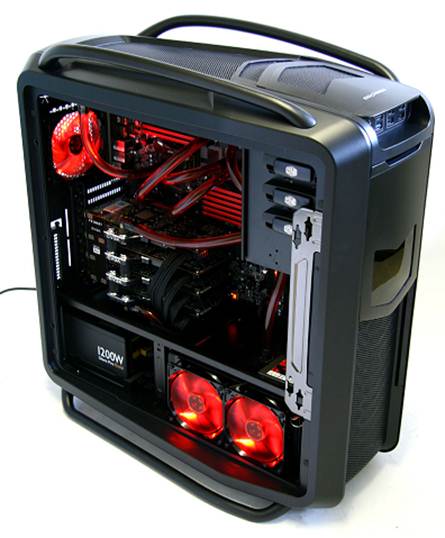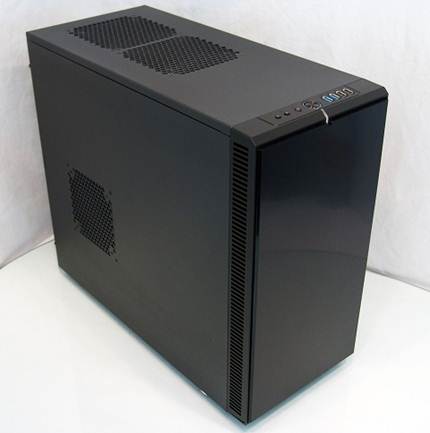Details
Price: $464
Manufacturer: Cooler Master
Website: www.coolermaster.com

Cooler Master is a company with no shortage
of experience in the high-end case market, but at $464 including VAT, this is a
case that will impact your wallet almost as hard as it will your senses. Little
can prepare you for the sheer enormity of the Cosmos 2. Without any hardware
installed it weighs 22 kg, and at over 70 cm tall it's the largest desktop case
we've ever tested. Despite the size of the case, the Cosmos looks gorgeous.
Clad in thick black soft-touch plastic and brushed aluminium, it oozes quality
from every pore, something only enhanced by the smooth sliding action of the
5.25" bay covers, and the two side panels that open like the doors of a
luxury saloon.
Inside the case you will find a large EATX
motherboard tray, 13 3.5" drive bays, three 5.25" bays and a
bottom-mounted PSU tray. Six of these bays can be easily removed for
replacement with a dual 240 mm water cooling radiator, and the top panel can
also be removed to accommodate a triple 120 mm radiator. As standard, the case
ships with a front 200 mm intake, a 120 mm exhaust for the roof and two 120 mm
fans designed to cool the drive bays. Two of the drive bays are lockable
'X-dock' drives, which allow you to quick-release hard drives from the front of
the chassis - handy if you need to take your data with you.
Under the sliding 'bonnet' on the roof of
the case, you will find a touch-sensitive panel. This includes the power
button, a reset switch, and four separate buttons that control the speed of the
case's fans. The fans are grouped into four different 'zones': the top, front,
HDD area and GPU areas. There's also a discrete button under this panel to turn
the case's LEDs on and off. Towards the front of the bonnet area you will find
the case's connectivity panel. There are four USB 2.0 ports, two USB 3.0 ports,
a single eSATA port and two audio jacks. Some might argue for the presence of a
FireWire port in a case that costs almost £300, but it just goes to show how
much of a fringe connectivity standard this is becoming since the release of USB
3.0.
Behind the motherboards tray there is ample
room to hide your unsightly cables, and it's just as well. The rear of the
Cosmos II is like spaghetti junction, with a myriad of leads feeding the fan
controller. As well as a three-pin power connection, each fan also has a
two-pin LED connection. Unless you're water cooling it's unlikely you will need
to use more than a few of these, but if you do need them, rest assured they're
available.
In terms of performance, the Cosmos II has
good if not spectacular temperatures. The lack of dedicated GPU cooling means
it runs warmer than the Xigmatek Elysium. The CPU and motherboard temperatures
are more impressive, but much of that is by virtue of the fact there's so much
breathing room.
There's no doubting the build quality of
the Cosmos - it truly is a triumph in this regard - but given its eye watering
price and the case's impractical size and weight, it will end up being an
object of lust rather than a realistic proposition for most of us.
Fractal Design Define R4
Details
Price: $143.98
Manufacturer: Fractal Design
Website: www.fractal-design.com

The cases we've examined so far appear
brash and arrogant when compared to the understated lines of the Define R4, but
for some users this will be the essence of its desirability. For every customer
who wants go-faster stripes and aggressive LED-illuminated vents, there will be
at least another who prefers clean lines and a minimalistic appearance. In many
ways the Define R4 owes its design ethos to high-end refrigerator
manufacturers: just go to your local department store and you will find rows
and rows of kitchen products that look almost exactly like scaled-up versions
of this case.
Swedish manufacturer Fractal Design specialises
in low-noise products, and the R4 is no exception. All internal panels have
been clad in noise absorbent material, with even the spare fan mounts plugged
with thick removable pads, which Fractal calls its 'ModuVents'. Leave them in
place and no noise will escape through these normally open vents. Take them all
out and you'll end up with a case with as much air cooling potential as any
other case in this group test. As standard, the R4 ships with two fans: a 140 mm
model at the front and another at the rear.
There's space at the front for another 140 mm
fan, space for two more at the top and another in the side. Peer inside and
you'll find yet another mount, this time at the bottom. Each of these can also
accommodate 120 mm models, so if you already invested in low-noise fans, you
can reuse them in this case.
Compared to the R3 that preceded the R4,
not a great deal has changed. The case is a little wider in order to
accommodate the larger fan units and the eight internal 3.5" bays can now
be split in two in order to accommodate oversized video cards -remove the upper
section and even the 12" 6990 will fit with ease. Fan speed can now be
controlled from the front of the case instead of via a rheostat at the rear,
and there are still only two 5.25" bays in the case rather than the more
conventional three or four. With the number of 5.25" bay devices dwindling
and users requiring optical drives less and less, this won't be a problem for
too many people - for those needing accommodation for more devices, the firm
offers an 'XL1 variant with four bays, albeit in a much larger chassis. All in
all, the changes in the case are evolutionary rather than revolutionary, but
then the R3 was a spectacular chassis already.
In operation, the R4 is practically noiseless
for all intents and purposes when the fans are set to low noise. Run them at
medium, and it's a match for any other case in the group test. Despite its low
noise credentials, the Fractal is well designed. Its CPU temperatures are only
a few degrees shy of the best cases here - something that could easily be
remedied should you wish to take advantage of the many fan expansion
opportunities available.
While its monolithic appearance may not
appeal to all users, the Define R4 is another great product from Fractal
Design. Its highly flexible nature makes it a suitable case for high-end gaming
machines and media PCs alike.